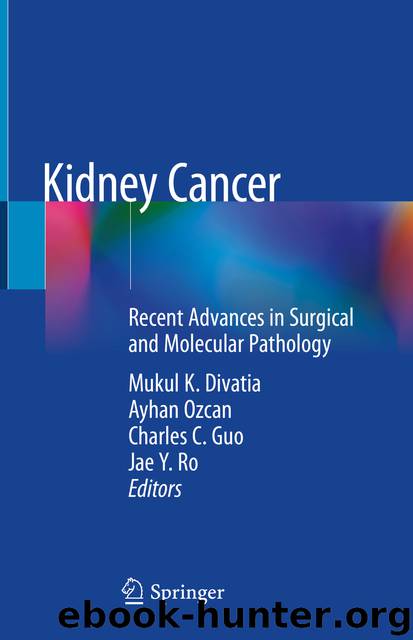Kidney Cancer by Unknown

Author:Unknown
Language: eng
Format: epub
ISBN: 9783030283339
Publisher: Springer International Publishing
The molecular/genetic features, pathogenetic mechanisms, and targeted therapy modalities for BHD-related renal tumor will be discussed together with its sporadic counterparts in the later chapters (see Chaps. 18 and 19).
Management, Genetic Counseling, and Treatment
BHD patients, like in VHL and HPRCC patients, involve active screening with renal imaging until their largest tumor nodule reach 3 cm. At this threshold, nephron-sparing surgery is recommended [26, 36, 37]. For small size tumors (<3 cm), percutaneous radiofrequency ablation or cryoablation can be performed, like in other HRCC syndromes [36, 46].
It should be emphasized that a subset (approximately 10%) of patients with germline mutations of the FLCN gene does not have the typical skin lesions [47]. Therefore, multiple, bilateral, and conglomerate renal tumors with a typical morphology should raise the possibility of BHD syndrome.
Molecular understanding of FLCN (BHD) gene pathway, including the function of FLCN, FNIP1, and FNIP2 protein complex, has enabled the development of target-specific drugs for advanced RCC in BHD patients. Rapamycin, the first inhibitor for mTOR, reduced tumor size and prolonged median survival in animals [35, 48]. Nowadays, new rapamycin analogs with more favorable pharmaceutical profiles, such as everolimus, temsirolimus, deferolimus, and zotarolimus, have been developed and are expected to be more effective with less adverse effects than rapamycin [48]. Targeted therapy modalities will be discussed later (see Chap. 19).
Download
This site does not store any files on its server. We only index and link to content provided by other sites. Please contact the content providers to delete copyright contents if any and email us, we'll remove relevant links or contents immediately.
Still Foolin’ ’Em by Billy Crystal(36301)
We're Going to Need More Wine by Gabrielle Union(19002)
Plagued by Fire by Paul Hendrickson(17368)
Pimp by Iceberg Slim(14433)
Molly's Game by Molly Bloom(14101)
Becoming by Michelle Obama(9974)
When Breath Becomes Air by Paul Kalanithi(8363)
Educated by Tara Westover(7999)
The Girl Without a Voice by Casey Watson(7842)
Note to Self by Connor Franta(7643)
The Incest Diary by Anonymous(7629)
How to Be a Bawse: A Guide to Conquering Life by Lilly Singh(7428)
The Space Between by Michelle L. Teichman(6891)
What Does This Button Do? by Bruce Dickinson(6166)
Imperfect by Sanjay Manjrekar(5833)
Permanent Record by Edward Snowden(5794)
A Year in the Merde by Stephen Clarke(5366)
Shoe Dog by Phil Knight(5215)
Promise Me, Dad by Joe Biden(5112)
